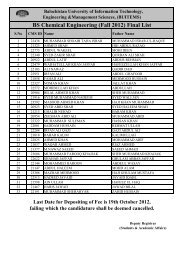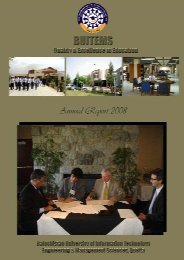BUITEMS
Research Journal - buitems
Research Journal - buitems
- No tags were found...
Create successful ePaper yourself
Turn your PDF publications into a flip-book with our unique Google optimized e-Paper software.
<strong>BUITEMS</strong><br />
Quality & Excellence in Education<br />
Optimization of Energy Consumption during Natural Gas Dehydration<br />
Abdul Qadeer 1* , Adnan Aftab 2 , Imran Nazir 3<br />
1<br />
Department of Chemical Engineering, 2 Department of Petroleum and Gas Engineering,<br />
Balochistan University of Information Technology Engineering & Management Sciences<br />
Quetta, 3 Department of Chemical Engineering, Mehran University of Engineering and<br />
Technology, Jamshoro, Pakistan.<br />
Abstract<br />
The aim of this work is to design an efficient Natural gas dehydration plant (using TEG as<br />
desiccant) in both terms i.e., optimized desiccants flow rate as well as optimized energy<br />
requirements. For this purpose the Natural Gas Plant of Hassan Gas Field, Shikarpur was<br />
selected as case model and the basic design study was carried out for the said plant. Natural<br />
gas is one of the important fossil fuels, used after treatment. Treatment includes removal of acid<br />
gases and dehydration. The major methods of dehydration are Direct Cooling, Absorption and<br />
Adsorption. The present work is the study of efficient design for Dehydration using absorption<br />
column by Triethylene Glycol (TEG) as desiccant. Efficiency of the Natural Gas Dehydration<br />
Column can be measured through optimized flow rates of desiccant or optimized energy<br />
requirements.<br />
Keywords:<br />
Energy Consumption, Natural Gas, Optimal Energy<br />
INTRODUCTION<br />
Pakistan is one of Natural gas dependent<br />
economies of the world. Pakistan has<br />
27.89527 TCFT proven reservoirs of gas. This<br />
include 34.78 MMCF of associated reservoirs<br />
(Pakistan Energy Yearbook, 2010). During the<br />
financial year 2009-10 Pakistan produced<br />
1482846 MMCFT (Pakistan Statistical Year<br />
Book, 2011).<br />
The pressure and temperature of natural gas<br />
are reduced, when the gas is produced from<br />
the reservior during flow from subsurface to<br />
wellhead; hence the gas yields liquid water<br />
condensate. Due to presence of water vapors<br />
in gas may cause gas hydrates in sale gas<br />
transmission lines which could stop gas<br />
transportation or supply (Donald and Robert,<br />
1990; Boyun and AIi 2005, Vincente et al,<br />
1992). Natural gas some time may contain<br />
H 2 S, which itself is a poisoning gas (Gas<br />
Processors Suppliers Association, 1987). It<br />
is necessary to remove H 2 S gas (gas<br />
sweetening) prior to the dehydration of NG<br />
because it may corrode transportation and<br />
processing facilities, which may create many<br />
health, safety and environment issues<br />
(Meyers, 2003).<br />
Natural gas dehydration may be achieved<br />
by four techniques i.e. direct cooling,<br />
compression followed by cooling,<br />
absorption and adsorption. In Absorber the<br />
hydrates are removed by hygroscopic liquid,<br />
i.e. ethylene glycol (EG), diethylene glycol<br />
(DEG), triethylene glycol (TEG), and<br />
tetraethylene glycol (T 4 EG) (Saeid et al.,<br />
2006; Lurance, 1978). Pipeline specification<br />
for water content in NG is 7lb m /MMSCF<br />
(Donald and Robert, 1990).<br />
TEG flow rate in absorption column is<br />
dependent on water content in the NG,<br />
commonly flow rate of 2 to 6 gallon of TEG/<br />
lb m of water with concentration of 99.0% to<br />
99.9% is used (Landreau et al., 1999; Kohl,<br />
and Riesenfeld, 1985).<br />
Process Description<br />
Sweet gas / wet gas delivered to the bottom<br />
of gas absorber tower and lean TEG is<br />
showered from top of the tower. Both gas<br />
and TEG solution counter affect each other<br />
during this phenomena.<br />
Glycol achieves solubility with water phase<br />
7
















